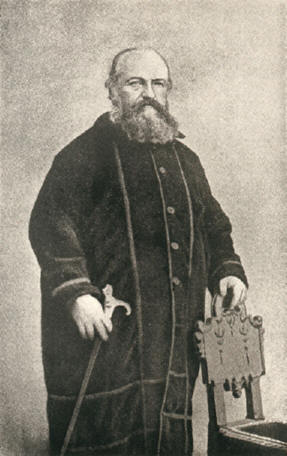|
|
||
|
Eliphas Levi
is the pseudonym of
Alphonse Louis Constant, a French occultist and author whose work
greatly influenced many of the early revivalists of the 19thcentury.
Interestingly, Aleister
Crowley was born the
same year Levi died and later claimed to be his reincarnation. Constant was born in Paris 1810 and was the only son of a shoemaker. At an early age he caught the attentions of a Parish Priest who arranged for Alphonse to be sent to seminary. It was here that he studied Roman Catholicism with the intent of joining the Priesthood. While he was there he became intrigued by his headmaster, who believed that animal magnetism was a vital energy of the human body controlled by the “Devil”. This sparked his curiosity and surreptitiously |
|
|
|
he began to study all that he could find out about magic and the occult. Constant continued to pursue his ecclesiastical career and was ordained as a priest. He gave up the collar of Catholicism to become an occultist. Some claim he was thrown out of the Church for his heretical views or as the story goes for "preaching doctrines contrary to the Church." Before his death in 1875 Lévi is said to have reconciled with the Catholic Church and died having received last rites.
In the 1830’s Constant became
acquainted with an old couple called 'Ganneau' who practiced
witchcraft. Constant
joined Ganneau and became one of his followers delving deeper into
the mysteries of magic and the occult. Constant continued to earn a living writing as a journalist and by giving lessons in occult studies. He took on the pen name 'Magus Eliphas Levi', which he arrived at by translating his first and second names from Hebrew. Levi first tried necromancy during a trip to London in 1854. A mysterious woman claiming to be an adept asked him to conjure the spirit of 'Apollonius' a famous magician of ancient times. During three week of preparation including dieting and fasting, he meditated on Apollonius and imagined conversations with him. The Ritual of Conjuration he performed consisted of 12 hours of incantations after which the floor began to shake and a ghostly apparition appeared. Levi admitted to feeling extremely cold and frightened and when the apparition touched his ritual sword his arm went suddenly numb. He dropped the sword and fainted. He claimed later that his sword arm was sore and numb for days after the incident, but that he was unconvinced he had conjured the spirit of Appollonius. In subsequent attempts though he claims to have called him up several times. In 1861 Levi published his first and perhaps most important book - The Dogma and Ritual of High Magic. He followed this with - A History of Magic, Transcendental Magic, The Key of Great Mysteries and other occult books. For his time Levi’s writings and beliefs were highly imaginative. He believed in the existence of a universal 'secret doctrine of magic' that had prevailed throughout history and was evident everywhere in the world. He also expounded the theory of 'Astral Light', based on his belief in animal magnetism. Astral light is likened to the ether, the life force and power source that fills all space and living things, a popular belief in the 19th century. A magicians 'will' was limitless in its power and to control the astral light he says, was to control all things. Levi was greatly influenced by “The Magus, 1801” written by Francis Barrett. He in turn would influence other great writers and occultists. One example is “Sir Edward Bulwer-Lytton”, the author of The Last Days of Pompeii and other occult books. They met in England in 1861, and together joined an occult group to study clairvoyance, magic, astrology and mesmerism. Up until his death in 1875, Levi earned his living from his writings and giving occult lessons, he was a popular man and gained a respectable cult following. His magic greatly influenced S.L. MacGregor Mathers who wrote much of the rituals adopted by the “Hermetic Order of the Golden Dawn” and which continues today as a leading influence in occultism. Levi is perhaps best known for his work regarding the alleged deity of the Knights Templar, Baphomet. Levi considered the Baphomet to be a depiction of the absolute in symbolic form. His treatment of the Baphomet Mythos is best seen in his illustration of the Baphomet shown below, which he used as a front piece to one of his many books. According to the author Michael Howard, he [Levi] based the illustration on a Gargoyle that appears on a building owned by the Templars; the Commandry of Saint Bris le Vineux. |
||
